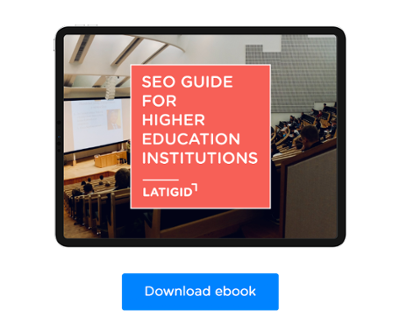
Lead generation for higher education is essential to attract and enroll new students. But with so many different lead generation strategies available, it can be difficult to know where to start or which ones are most effective.
In this blog post, we'll share five higher education lead generation tips that work. These tips are based on our experience working with a variety of higher education institutions, and they're proven to generate high-quality leads that can be converted into enrolled students.
Whether you're a small community college or a large research university, these tips can help you reach your target audience and generate more leads for your institution.
Why is higher education lead generation important?
Higher education lead generation is important for several reasons, both for educational institutions and for prospective students. Here are some key reasons why higher education lead generation matters:
Student recruitment: Higher education institutions rely on a constant influx of new students to thrive. Lead generation helps identify and attract potential students who may be interested in enrolling in various programs and courses.
Diverse student body: Lead generation efforts can target a diverse range of students, including those from different backgrounds, demographics, and geographic locations. This diversity enriches the educational experience and contributes to a more vibrant campus community.
Financial sustainability: Educational institutions often depend on tuition fees and other sources of revenue to operate effectively. Lead generation helps ensure a steady stream of revenue by enrolling students who can pay tuition and fees, thereby contributing to the financial sustainability of the institution.
Quality control: Lead generation allows institutions to attract students who are a good fit for their programs and are more likely to succeed academically. This can lead to higher retention rates and a better overall educational experience.
Competitive advantage: In a competitive higher education landscape, institutions need to actively market themselves to stand out. Effective lead generation can give an institution a competitive edge by reaching potential students before competitors do.
Meeting enrollment goals: Many institutions set specific enrollment targets to maintain a certain student-to-faculty ratio or to justify budgets. Lead generation helps institutions meet these goals and ensure they have the necessary resources to provide quality education.
Long-term alumni engagement: Lead generation is not just about attracting students; it's also about nurturing relationships that can extend beyond graduation. Engaging with potential students early on can lead to stronger alumni networks and ongoing support for the institution.
Adapting to market trends: Lead generation efforts can help institutions identify emerging trends in student preferences, program demand, and educational delivery methods. This data can inform curriculum changes and strategic planning.
Global reach: In an era of globalization, higher education institutions often seek to attract international students. Lead generation allows them to reach prospective students from around the world, diversifying the student body and increasing cultural exchange.
Data-driven decision-making: Lead generation involves collecting and analyzing data on prospective students. This data can be used to make informed decisions about marketing strategies, program development, and resource allocation.
Improving educational access: Lead generation can identify potential students who might not otherwise consider higher education due to various barriers. By reaching out to these individuals, institutions can help improve educational access and equity.
Related article: How Lead Generation Drives Growth for Universities
5 higher education lead generation tips that work
Effective higher education lead generation requires a well-planned strategy and the use of various marketing techniques. Here are five lead generation tips that have proven to be effective:
Optimize your website
- Your institution's website is often the first point of contact for potential students. Ensure it is user-friendly, mobile-responsive, and optimized for search engines (SEO).
- Create dedicated landing pages for specific programs or courses, making it easy for visitors to find information about their areas of interest.
- Implement clear calls-to-action (CTAs) on your website, such as "Request Information" or "Apply Now" buttons.
Develop a content marketing strategy
- Develop a content marketing strategy that includes blog posts, articles, videos, and other informative content related to your programs and the higher education experience.
- Address common questions and concerns that prospective students may have, such as admission requirements, financial aid, and career prospects.
- Share your content on social media and use email marketing to reach and engage with potential students.
Use social media advertising
- Use social media platforms like Facebook, Instagram, and LinkedIn to run targeted advertising campaigns.
- Segment your audience based on demographics, interests, and behaviors to reach the most relevant prospects.
- Create compelling ad copy and visuals that highlight the unique aspects and benefits of your institution.
Invest in paid search advertising
- Invest in paid search advertising (e.g., Google Ads) to appear prominently in search results when prospective students are actively searching for educational programs.
- Use keyword research to identify the terms and phrases potential students are using to find programs like yours.
- Continuously monitor and optimize your SEM campaigns for better performance.
Promote lead magnet offers
- Offer valuable resources or incentives in exchange for prospective students' contact information. These can include eBooks, webinars, virtual campus tours, or sample course materials.
- Promote these lead magnets across your website and marketing channels.
- Once you collect contact information, nurture these leads through email marketing campaigns, providing them with additional information and opportunities to engage with your institution.
Bonus tip
- Tailor your communications and content to individual prospective students whenever possible. Personalization can significantly improve engagement and conversion rates. Use data analytics to better understand your leads and send them relevant, personalized messages.
Remember that effective lead generation is an ongoing process that requires monitoring and adaptation. Continuously analyze your results, track key performance indicators (KPIs), and refine your strategies based on what works best for your institution and your target audience.
Related article: Lead Generation for Higher Education: Turning Leads into Students
About LATIGID
We are a higher education marketing agency. We help you grow by increasing website traffic, generating more student leads, and closing those leads into enrollment. With a deep understanding of the latest industry trends and best practices, we are well equipped to help your institution grow.
If you are looking for a higher education marketing agency to partner with, check our page to see what we can do for you!
Download our SEO guide and learn how to build a strategy to optimize your Higher Education Institution's website







